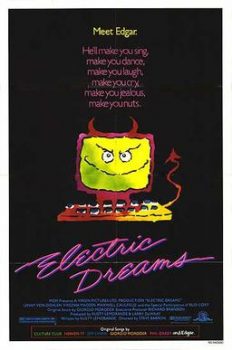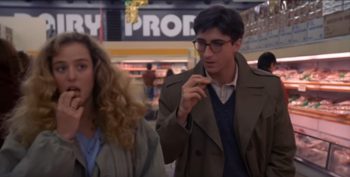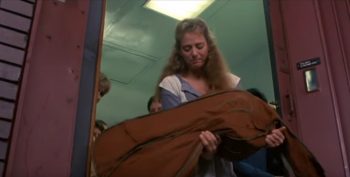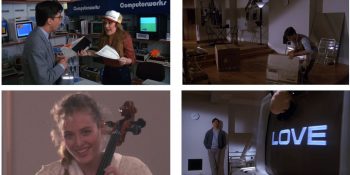Not Streaming: Electric Dreams

In 1984, the movie Electric Dreams was released, providing a prescient view of the capabilities computers would eventually have. At the same time, as one of the first films directed by a music video producer, Steve Barron, the film made heavy use of MTV style montages during some of its musical sequences.
The film opens with a montage at the airport as a technophobic Miles Harding (Lenny van Dohlen) tries to catch a flight. The scenes in the airport establish how pervasive technology is in the world, with shots of computers, printers, computerized toy cars, and calculators. Upon arriving at his architectural firm in San Francisco, a friend shows Miles his electronic organizer. The conversation is seen through the lens of a surveillance camera in the company’s elevator. Miles goes to buy one, but is talked into purchasing the latest computer from the store clerk.
Although the computer Miles purchased looks like an Apple available in the early 80s, it had capabilities more in line with a modern Alexa. Within moments of unboxing the computer, Miles is connecting it to run his blender, coffee machine, stereo, and home security system. When he hacks into his boss’s computer to gain the information he needs so the computer can help him design an earthquake resistant brick, the computer begins to malfunction and he pours champagne on it, resulting in a computer that begins to gain sentience.
While all this is going on, Miles gets a new neighbor, when classical cellist Madeline Robistat (Virginia Madsen) moves into the upstairs apartment. Despite making a bad first impression on her, when they bump into each other in a grocery store, the strike up a relationship. Miles is as awkward around women as he is around computers, but Madeline is intrigued when she hears music coming from his apartment, playing a duet as she practices and thinks it is Miles.

A visit to Miles’ apartment has him trying to hide the computer from Madeline, as if it was some dark secret to be embarrassed about. While it makes sense for him not to want to admit that his computer has become sentient, although at this point in the story he is not aware of how sentient it is, hiding the computer itself seems a strange decision.
With the computer learning how to think, Electric Dreams takes a lot of its inspiration from Rostand’s play Cyrano de Bergerac, with Miles enlisting the computer (voiced by Bud Cort) to write a song for Madeline. Miles knows that Madeline loves music and is fascinated by the music she thinks he played, so he wants to give her more. While relying on the computer to provide him with something (and coaching the computer regarding what is appropriate), Miles actually does build a relationship with her, even if it is based on his dishonesty.
Eventually, as the computer continues to learn and become more sentient, it takes on more menacing tones, reaching out to Miles when he is at work, making demands of Miles, and trying to understand the emotion that Miles and Madeline may feel for each other, while adopting that emotion as his own. The latter part of the movie has the formerly benevolent computer taking on strong undertones of the HAL 9000 from 2001: a space odyssey, although with more emotion than that stoic computer.
Although Miles’ dishonesty in dealing with Madeline is troublesome, when he asks Madeline what she sees in him, she actually does come up with a lengthy list of reasons she wants to continue to see him. The lack of transparency is simply not an issue for her, even if it might be an issue for someone watching the film in 2021. Looking at the film from a distance of nearly four decades, there is a strange sense of innocence to the film beginning with the first scene where Miles is able to buy a plane ticket from a vending machine in an airport and walk to his departure gate even as the announcement is being made that his flight has already started boarding. Similarly, his experience with his neighbors, both Madeline upstairs and his next door neighbors who object wen the computer begins playing loud music, seems like it is from a simpler time.

While the human element of Electric Dreams may be lacking, the view it offers of the way technology would infiltrate every aspect of our lives is strangely accurate. A direct line can be drawn from Miles’ computer to the devices that we surround ourselves with. The ubiquity of basic computers shown in the film’s opening sequence is a given in modern society, as is the ever present surveillance devices that so much of the opening of the film is seen through.
In many ways the film serves as an odd snapshot in time, showing us what the promise of computers where on the cusp of major innovations (the year the film came out was also when Apple introduced the MacIntosh). It is interesting that for all the bells and whistles Miles’ computer has: Spoken input, external modem, connectivity throughout the house, there isn’t a mouse in sight.
The film helped launch Madsen’s career. Only her second cinematic credit, later that same year she would appear as Princess Irulan in David Lynch’s Dune. It was also the second cinematic credit for van Dohlen, who would later appear in Twin Peaks. Interestingly, but not, perhaps coincidentally, van Dohlen is currently making a film in which a computer designed to flag violent internet content starts creating its own, with its inventors as the subjects.
In 2017, van Dohlen and Madsen had the chance to discuss their experiences making Electric Dreams.
Electric Dreams is not currently streaming on any service. DVDs and BluRays can be purchased, although they appear to be encoded for Region 2 players.

 Steven H Silver is a seventeen-time Hugo Award nominee and was the publisher of the Hugo-nominated fanzine Argentus as well as the editor and publisher of ISFiC Press for 8 years. He has also edited books for DAW, NESFA Press, and ZNB. His most recent anthology, Alternate Peace and his novel After Hastings, was published in 2020. Steven has chaired the first Midwest Construction, Windycon three times, and the SFWA Nebula Conference 6 times, as well as serving as the Event Coordinator for SFWA. He was programming chair for Chicon 2000 and Vice Chair of Chicon 7.
Steven H Silver is a seventeen-time Hugo Award nominee and was the publisher of the Hugo-nominated fanzine Argentus as well as the editor and publisher of ISFiC Press for 8 years. He has also edited books for DAW, NESFA Press, and ZNB. His most recent anthology, Alternate Peace and his novel After Hastings, was published in 2020. Steven has chaired the first Midwest Construction, Windycon three times, and the SFWA Nebula Conference 6 times, as well as serving as the Event Coordinator for SFWA. He was programming chair for Chicon 2000 and Vice Chair of Chicon 7.